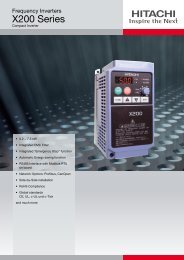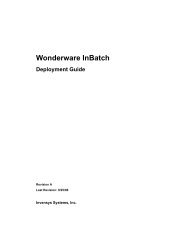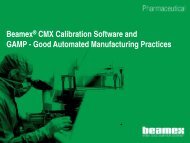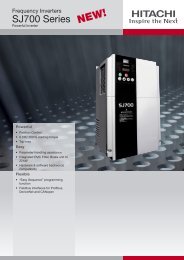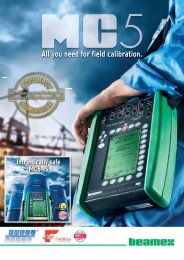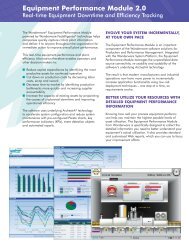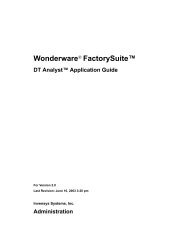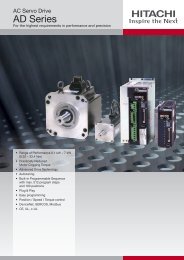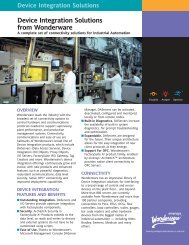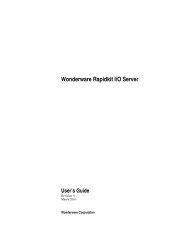SATEL SATELLAR Digital System SCADA A4.indd
SATEL SATELLAR Digital System SCADA A4.indd
SATEL SATELLAR Digital System SCADA A4.indd
You also want an ePaper? Increase the reach of your titles
YUMPU automatically turns print PDFs into web optimized ePapers that Google loves.
UTILITY DISTRIBUTION, <strong>SCADA</strong><br />
• TCP/IP • INTEGRATED MODULAR SOLUTION • DSP RADIO WITH 20 MHz TUNING RANGE • LINUX OS<br />
<strong>SATEL</strong>LAR <strong>Digital</strong> <strong>System</strong><br />
For Long Range Wireless Data
DIGITAL RADIO MODEM SYSTEM<br />
• TCP/IP • INTEGRATED MODULAR SOLUTION • DSP RADIO WITH 20 MHz TUNING RANGE • LINUX OS<br />
<strong>SATEL</strong>LAR is a new generation digital radio<br />
modem system that consists of several different<br />
units:<br />
• Central unit (CU)<br />
• Radio unit (RU)<br />
• Expansion units (XU)<br />
<strong>SATEL</strong>LAR enables the building of an independent,<br />
reliable, real-time radio data communication<br />
system that meets the specific<br />
needs of the customer.<br />
Typically, a central unit together with a radio unit are used in a<br />
network as a master station or in locations where an Ethernet<br />
connection is needed. For radio router stations, the central unit<br />
is not necessarily required. In these cases, the radio unit can be<br />
used alone. This is possible because of the modular structure of<br />
the product.<br />
<strong>SATEL</strong>LAR units are available as separate entities or as combined<br />
product packages:<br />
• the <strong>SATEL</strong>LAR-2DS includes a radio unit and a central unit,<br />
which enables full TCP/IP connectivity.<br />
• the <strong>SATEL</strong>LAR-2DSd provides the same functionality as<br />
the <strong>SATEL</strong>LAR-2DS, but it is equipped with a colour display<br />
and a keypad.<br />
• the <strong>SATEL</strong>LAR-1DS is a radio unit that can be used in stations<br />
where a standard RS-connection is suffi cient.<br />
Data communication<br />
<strong>SATEL</strong>LAR can operate either as a transparent radio link, essentially<br />
replacing a wire, for classic RS-232, RS-485 or RS-422<br />
based protocols, or can operate as a wireless bridge / router in<br />
an IP-based network.<br />
Using <strong>SATEL</strong>LAR many network topologies are possible, from<br />
point-to-point link to a nationwide chain with multiple branches.<br />
Range<br />
With a <strong>SATEL</strong>LAR radio the communication range of a pointto-point<br />
link is typically over 10 km in urban conditions (some<br />
obstacles to line of sight) and over 20 km for ideal line of sight<br />
conditions.<br />
The range can be further extended using high gain antennas,<br />
booster modules and radio repeaters. Any <strong>SATEL</strong>LAR can provide<br />
both connectivity to a local node and operate as a wireless<br />
router.<br />
Security<br />
Data security is typically a concern when using radio communication.<br />
In <strong>SATEL</strong>LAR, information security was a design priority;<br />
128 bit encryption on the air interface and the use of built in<br />
fi rewall in the central unit ensures privacy both in the radio<br />
network and in the wired IP network.<br />
Network management system<br />
Radio modems are often used in applications where reliability<br />
and independence are key properties. To support this demand,<br />
<strong>SATEL</strong>LAR has built-in diagnostic and remote confi guration<br />
features (NMS, SNMP, WWW). These features can be accessed<br />
using any of the many user interfaces <strong>SATEL</strong>LAR provides.<br />
USER INTERFACES (UI)<br />
Ease of use has been built into <strong>SATEL</strong>LAR by various means,<br />
all designed to keep the user up to date with the status of the<br />
device and to provide easy access to detailed status and confi<br />
guration data.<br />
Local use<br />
The status of the device can be seen at a glance from the LEDs<br />
of each unit. A more detailed view is available using the display<br />
and the seven keys of the central unit.<br />
Remote use<br />
Once deployed, status monitoring and confi guration can be<br />
performed using one of two methods:<br />
1) <strong>SATEL</strong> NMS PC software either through the RS-232 port of<br />
the radio unit or the USB device port of the central unit.<br />
2) IP connectivity (Ethernet interface of central unit).<br />
• SNMP for industry-standard diagnostics and confi guration.<br />
• Each central unit hosts a web page showing its status and<br />
allowing remote confi guration.<br />
Over the air<br />
Any station in a network can be accessed over the air by any of<br />
the remote user interface methods described above.<br />
Radio unit<br />
Expansion unit<br />
Central unit<br />
A COMPLETE SOLUTION
FLEXIBLE AND<br />
EXPANDABLE<br />
The <strong>SATEL</strong>LAR family is designed to be fl exible and expandable<br />
both in terms of hardware and software functions.<br />
Software<br />
The central unit, with its Linux operating system, allows<br />
customers to create their own software applications for the<br />
modem, possibly eliminating the need for any devices other<br />
than <strong>SATEL</strong>LAR on the site.<br />
In the radio unit the modulation method, channel spacing<br />
and forward error correction can be selected by changing the<br />
modem settings. Also the RF output power can be set.<br />
Hardware<br />
Due to the modular mechanical design, it is possible to<br />
add customer-specifi c or <strong>SATEL</strong>-standard expansion units in<br />
between the central and radio units – even after the initial<br />
deployment, as an update. The USB host and device connectors<br />
of the central unit offer the possibility of connecting<br />
commercially available USB devices like Bluetooth and WLAN<br />
modules to the modem or to e.g. show the modem as an<br />
external memory device to a PC.<br />
The radio unit allows a 20 MHz tuning range and the selection<br />
of channel spacing.<br />
Examples of features supported by adding hardware extension<br />
units:<br />
• 10 W output power<br />
• Industrial grade RS-485/422 ports (with galvanic isolation)<br />
• I/O module (for site monitoring and simple I/O control)<br />
Mounting<br />
The device can be mounted directly on a fl at surface or on<br />
a DIN rail. DIN-rail mounting is possible either on from the<br />
back-side of the device (for local UI use) or from the side of<br />
each unit (LED indicators remain visible for the user).<br />
Ruggedised<br />
<strong>SATEL</strong>LAR units are constructed of die-cast aluminium to<br />
withstand the wear and tear typical of harsh industrial environments.<br />
<strong>SATEL</strong>LAR is designed to operate over a wide temperature<br />
range and even under the severe vibration common to<br />
vehicular or process industry applications.<br />
TECHNICAL SPECIFICATIONS, RADIO UNIT<br />
RADIO PARAMETERS<br />
Frequency range 380 - 520 MHz *1)<br />
Tuning range<br />
>20 MHz<br />
Channel spacing<br />
12.5 and 25 kHz, selectable<br />
Carrier frequency confi guration Frequency programmability in 6.25 kHz steps<br />
Carrier frequency accuracy +/- 2.5 ppm, at temp. -25 - +55 o C<br />
Carrier frequency long term +/-2.0 ppm / 3 years<br />
stability<br />
Data latency<br />
TWO MODES OF DATA TRANSFER<br />
A <strong>SATEL</strong>LAR <strong>Digital</strong> <strong>System</strong> can be used in<br />
either transparent or packet-based transfer<br />
mode. Selecting the right mode for the<br />
intended application ensures optimum<br />
performance and the best use of the radio<br />
channel for each application.<br />
Transparent mode<br />
The transparent transfer mode is intended for RS-232-,<br />
RS-485- or RS-422-based protocols (MODBUS, PROFIBUS,<br />
etc.). In this mode, any data sent to the modem DTE port<br />
will be transferred over radio to either all recipients directly<br />
or routed through a radio modem network using message<br />
routing (data destination address retrieved from protocol or<br />
set statically).<br />
This enables the construction of large modem networks (several<br />
hundred modems) using existing widely adopted communication<br />
protocols. This mode of data transfer is optimised<br />
for low latency and relies on the used protocol to handle<br />
the communication discipline on the air interface. A pointto-point<br />
data latency in the order of 10 ms can be achieved<br />
with this mode of data transfer.<br />
For transparent modem operation the central unit is not<br />
required. The radio unit handles the bulk of the workload,<br />
the central unit is used merely for USB / Ethernet connectivity<br />
and provides a local UI for the modem.<br />
Packet mode data transfer<br />
The packet mode data transfer is optimised for ease of use<br />
rather than latency. The modem takes care of collision avoidance<br />
on the air interface and packet routing in the radio<br />
modem network. This mode enables IP transfer (TCP/UDP)<br />
over a radio modem, thus easily achieving licensed reliable<br />
IP communication links of a wide range (>10 km), not easily<br />
achievable using other technologies.<br />
Packet mode transfer can be set up with the radio unit alone.<br />
However, to achieve maximum performance and to utilise all<br />
potential of the <strong>SATEL</strong>LAR (for example local IP connectivity)<br />
the stations should be equipped with central units.<br />
TAILORED FOR YOUR APPLICATION
<strong>SCADA</strong> EXAMPLE 1: ALL IP<br />
An example of a system using IP in all nodes of the network. Each station can serve as a radio<br />
router to extend the radio coverage. Each station can serve either only one client or provide a<br />
wireless uplink to an entire IP network on a substation consisting of many units.<br />
Network management is done using SNMP, thus seamlessly integrating the radio network into<br />
the company IP transfer hierarchy.<br />
<strong>SCADA</strong> EXAMPLE 2: RS-232 WITH NMS<br />
An example of a system using transparent transfer mode. Central units are needed only in the<br />
master station to provide IP or USB connectivity to the computer running the <strong>SATEL</strong> NMS PC<br />
software.<br />
TAILORED FOR YOUR APPLICATION
<strong>SATEL</strong>LAR DIGITAL SYSTEM<br />
IN UTILITY DISTRIBUTION<br />
<strong>SCADA</strong> systems are an essential part of any up-to-date utility distribution<br />
infrastructure. In many cases <strong>SCADA</strong> stands for concentrated and efficient<br />
handling of critical operations such as automated control, management<br />
and maintenance of, for example, distribution networks.<br />
The <strong>SATEL</strong>LAR digital system as a data transfer method in <strong>SCADA</strong> systems<br />
offers real-time, operator-free and secure connection.<br />
Because of the integrated modular solution and versatile features of the<br />
<strong>SATEL</strong>LAR digital system, it enables many different kinds of network solutions<br />
i.e. IEC 60870-5-101, DNP 3.0, Modbus, Profibus etc. or, alternatively,<br />
protocols based on the IP-protocol stack (TCP/UDP). The following<br />
describes the possible use of the <strong>SATEL</strong>LAR digital system through a set of<br />
application-specific examples.<br />
ELECTRICITY<br />
In power distribution networks, which are sensitive to problematic<br />
situations, possible breaks in distribution must be kept as<br />
short as possible. This requires a reliable monitoring and control<br />
network. With radio modems it is easy to set up a network<br />
that monitors the condition of the power grid and link stations.<br />
If problems arise, malfunctioning stations can be pinpointed<br />
quickly and in some instances restored remotely.<br />
• Remote control and monitoring of the power divider stations<br />
• I/O data transfer from the stations<br />
• Monitoring of the electricity distribution networks’<br />
voltage variation<br />
APPLICATIONS
WATER<br />
Radio modems are used widely for the remote control and<br />
monitoring of waterworks and sewage processing plants.<br />
Since these installations are often in remote locations or cover<br />
a large area, the data network needs to be fl exible, easy to<br />
extend and above all reliable. In water distribution plants,<br />
interruptions must be kept to a minimum, and problems addressed<br />
instantly. This puts additional pressure on the reliability<br />
and integrity on the monitoring and control network. With<br />
<strong>SATEL</strong> radio modems, real-time monitoring networks can be<br />
confi gured and expanded according to demand. The network<br />
may cover, for example, pumping stations, water reservoirs<br />
and distribution substations. <strong>SATEL</strong> modems are also used to<br />
monitor water usage, fl ow or other parameters:<br />
• Monitoring of the fl ow and pressure of the water system<br />
• Temperature depended irrigation for farming (agriculture)<br />
• Overfl ow gate control<br />
• Monitoring of leaks in water distribution systems<br />
• Remote control of pumping stations<br />
• Remote measurement of water level<br />
GAS/OIL<br />
<strong>SATEL</strong> radio modems are primarily used for monitoring<br />
gas compression and pressure reduction stations. To easily<br />
generate radio coverage over a vast geographical area, each<br />
radio modem can serve as a datalink for local RTUs and at<br />
the same time route/relay messages to other radio modems.<br />
<strong>SATEL</strong> radio modems can easily be used to control devices<br />
such as boiler controllers (gas temperature setting after pressure<br />
reduction) or injection gas odorisers (THT concentration<br />
proportioning and odoriser controller reset).<br />
• Monitoring of pipeline pressure changes<br />
• Collecting production volumes from pumping stations<br />
• Remote control of pumping stations<br />
WIND<br />
Wind turbines are usually erected in remote locations so as<br />
to minimise noise pollution. Laying in data cables can prove<br />
expensive, thus making radio modems a natural choice for<br />
monitoring and controlling these innovative energy sources.<br />
Since wind turbines require constant monitoring to ensure the<br />
best possible energy output, the communications used must<br />
be reliable and fast. With <strong>SATEL</strong> radio modems, setting up a<br />
fl exible data transfer network is easy and more importantly,<br />
reliable.<br />
• Monitoring of wind power plants:<br />
- Amount of produced energy<br />
- Wind speed, humidity, temperature<br />
• Wind mill maintenance<br />
APPLICATIONS
<strong>SATEL</strong>LAR <strong>Digital</strong> <strong>System</strong><br />
For Long Range Wireless Data<br />
More than just a radio modem<br />
– a complete solution<br />
<strong>SATEL</strong>LAR’s integrated modular solution and Linux platform<br />
allow you to build the perfect solution for your specific need.<br />
<strong>SATEL</strong>LAR allows us at <strong>SATEL</strong> to serve you even better and<br />
further than before.<br />
<strong>SATEL</strong>LAR-2DSd<br />
<strong>SATEL</strong>LAR-2DS<br />
<strong>SATEL</strong>LAR-1DS<br />
<strong>SATEL</strong>LAR-2DSd<br />
Radio unit + central unit<br />
with display<br />
Radio unit + central unit<br />
without display<br />
Radio unit only<br />
with expansion unit<br />
<strong>SATEL</strong> reserves the right to change the technical specifi cations or functions of its products.<br />
Designed and manufactured in Finland by:<br />
Distributor:<br />
<strong>SATEL</strong> Oy,<br />
Meriniitynkatu 17, P.O. Box 142,<br />
FI-24101 Salo, FINLAND<br />
Tel. +358 2 777 7800 info@satel.com<br />
Fax +358 2 777 7810 www.satel.com



